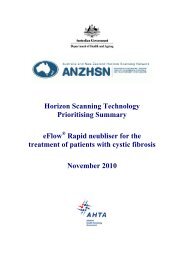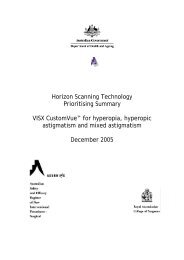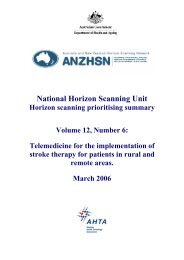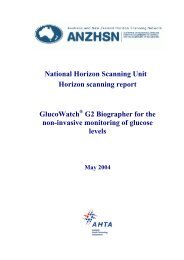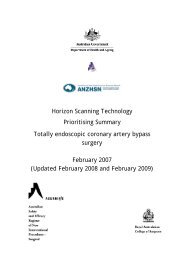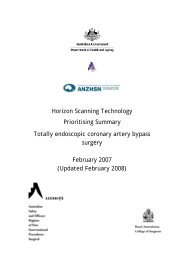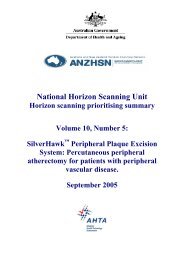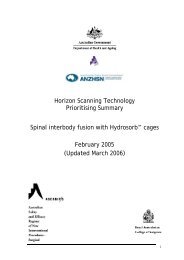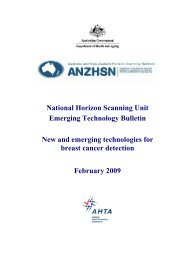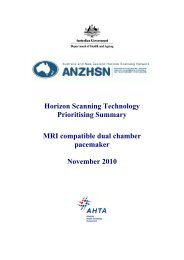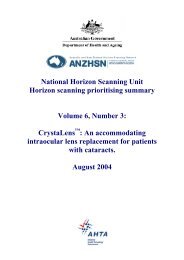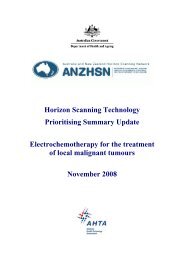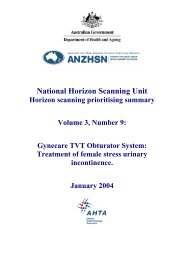Narrow Band Imaging for the improved detection of precancerous ...
Narrow Band Imaging for the improved detection of precancerous ...
Narrow Band Imaging for the improved detection of precancerous ...
You also want an ePaper? Increase the reach of your titles
YUMPU automatically turns print PDFs into web optimized ePapers that Google loves.
92% (95% CI [89, 94]) and overall specificity was 86% (95% CI [80, 91]). Thepooled results <strong>of</strong> a comparator technique called chromoendoscopy 1 found similardifferentiation results with a sensitivity <strong>of</strong> 91% (95% CI [83, 96]) and a specificity <strong>of</strong>89% (95% CI [83, 93]). The review also looked at four studies which reported oninter-operator agreement using NBI. The results showed good to perfect agreementbetween operators in four studies (κ values ranging from 0.64 to 1.0, with three <strong>of</strong> <strong>the</strong>four studies reporting very high κ values). Overall <strong>the</strong> review shows that NBI isunproven <strong>for</strong> <strong>the</strong> <strong>detection</strong> <strong>of</strong> neoplasia but comparable to established techniques <strong>for</strong><strong>the</strong> differentiation <strong>of</strong> lesions (van den Broek et al 2009) (Level I Diagnosticevidence).A study <strong>of</strong> 47 consecutive patients compared <strong>the</strong> ability <strong>of</strong> NBI to detect colorectallesions versus WLE. Patients confirmed to have neoplastic lesions were <strong>the</strong>n blindlyassessed using NBI at a separate institute. The procedure at <strong>the</strong> second instituteconsisted <strong>of</strong> analysing a segment <strong>of</strong> colon with only NBI <strong>the</strong>n reviewing <strong>the</strong> resultsfrom <strong>the</strong> first institute. If it was confirmed that a lesion was missed <strong>the</strong>n <strong>the</strong>colonoscope was switched to WLE mode and <strong>the</strong> operator attempted to investigate <strong>the</strong>discrepant lesions. Although NBI detected more neoplasia overall (NBI: 134/153 vsWLE: 116/153; p = 0.02), 12 per cent <strong>of</strong> <strong>the</strong> lesions detected by WLE were missedusing NBI. WLE missed 24 per cent <strong>of</strong> lesions detected by NBI (Uraoka et al 2009)(Level III-2 Diagnostic evidence).The ability <strong>of</strong> NBI to detect oesophageal lesions in a population with known lesionswas compared to WLE and WLE plus iodine staining. The population consisted <strong>of</strong> 90subjects with a mean age <strong>of</strong> 57 years. Lesions were confirmed with pathology. Theresults showed that iodine staining detected 100% (138/138) <strong>of</strong> <strong>the</strong> lesions, with NBIand WLE detecting 87.0% (120/138) and 75.4% (104/138) <strong>of</strong> <strong>the</strong> lesions, respectively(Huang et al 2009) (Level III-2 Diagnostic evidence).Using histology as <strong>the</strong> gold standard, NBI and lugol chomoendoscopy 2 werecompared <strong>for</strong> <strong>the</strong> <strong>detection</strong> <strong>of</strong> lesions in a patient population <strong>of</strong> 142 with head andneck squamous cell carcinoma (SCC). Sixteen patients were found to haveoesophageal lesions by NBI (21 lesions total, 15 clinically important). Nineteenadditional patients were found to have additional lesions by lugol chomoendoscopy(22 lesions total, 1 clinically important). Compared to <strong>the</strong> gold standard <strong>of</strong> histologyNBI showed a sensitivity <strong>of</strong> 90.9% (95 % CI [58.7, 99.8]) and a specificity <strong>of</strong> 95.4%(95 % CI [90.3, 98.3]) <strong>for</strong> <strong>the</strong> <strong>detection</strong> <strong>of</strong> clinically important lesions (Takenaka et al2009) (Level III-2 Diagnostic evidence).Watanabe et al (2009) used WLE to detect laryngeal lesions in a patient populationundergoing laryngoscopy at a Japanese clinic. WLE detected 35 suspected lesions in31 Chromoendoscopy is endoscopy using dyes to increase contrast <strong>of</strong> target lesions.2 Lugol’s Iodine is a stain that helps discriminate between lesions and normal tissue.3 The total number <strong>of</strong> patients assessed was not reported<strong>Narrow</strong> band imaging <strong>for</strong> <strong>the</strong> <strong>detection</strong> <strong>of</strong> <strong>precancerous</strong> lesions: November 2009 Update 2



